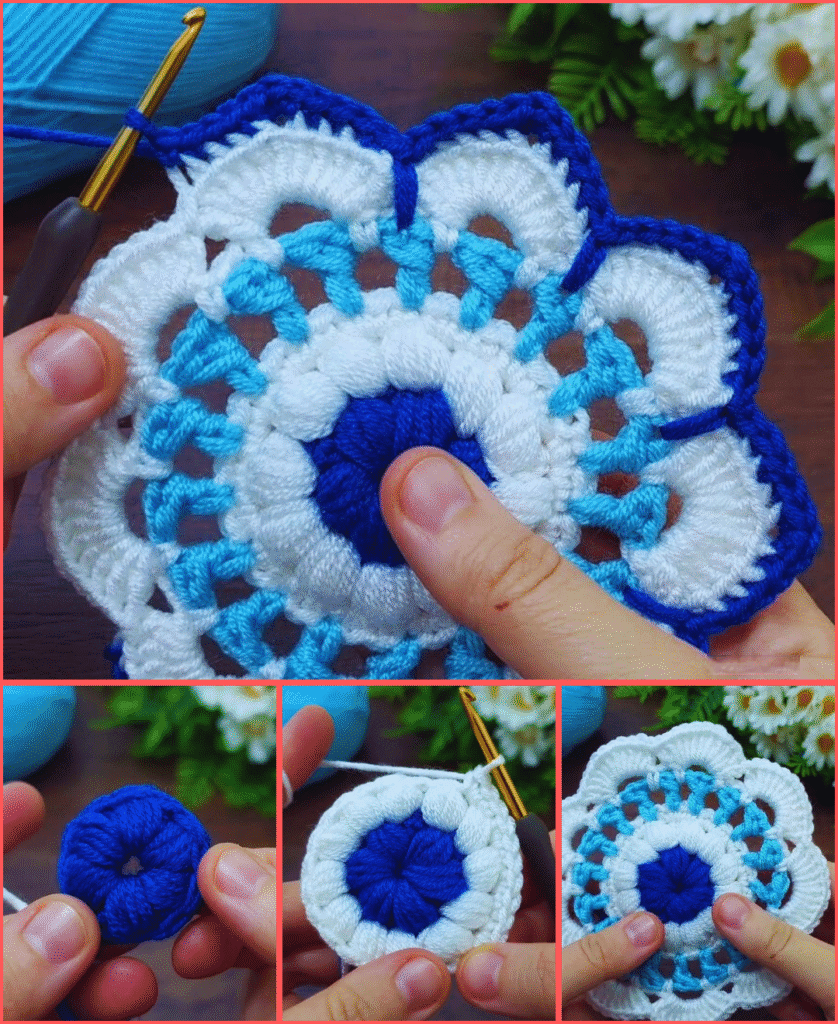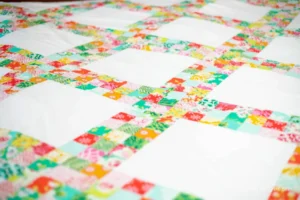The Crochet Flower Coaster Pattern is one of the most charming and practical projects for crochet enthusiasts. Whether you’re a beginner looking for a simple yet elegant creation or an advanced crocheter aiming to use up your yarn scraps, Crochet Flower Coasters are the perfect choice. Their delightful floral design not only adds beauty to your space but also protects your surfaces from heat and moisture.
Creating a Crochet Flower Coaster gives you the chance to express your creativity while practicing key crochet techniques like magic rings, increasing, and changing colors. These coasters are compact and quick to finish, making them excellent as last-minute gifts, party favors, or decorative pieces. The best part is, they require minimal materials, which makes them ideal for any budget.
Throughout this article, we’ll explore the details of making a Crochet Flower Coaster Pattern, including materials needed, step-by-step construction, color inspirations, and variations you can try. We will also answer the most common questions in a comprehensive FAQ at the end. So if you’re ready to add a splash of floral charm to your home with a useful and stylish touch, this guide is for you.

Materials You’ll Need for Your Crochet Flower Coaster Pattern
To start working on your Crochet Flower Coaster, you don’t need much—just a few basic tools and some yarn. Most flower coaster patterns are adaptable and can be customized based on what you have on hand.
First, you’ll need cotton yarn. This type of yarn is absorbent and ideal for coasters, as it won’t melt under hot mugs or glasses. Choose colors that reflect your personal style or match your decor. Soft pastels or vibrant rainbow shades both work beautifully for this type of project.
Next, you’ll need a crochet hook, usually between 3.5mm and 4.5mm, depending on your yarn. The label on your yarn will recommend a hook size, and it’s best to stick with that for the perfect tension. A smaller hook gives tighter stitches, which is better for durability.
Don’t forget your scissors and a yarn needle. The scissors will be used to cut your yarn ends neatly, and the yarn needle is for weaving in loose ends at the end of the project. Some crafters also keep a stitch marker handy, especially when working in the round.
If you’re using a pattern for your Crochet Flower Coaster, it may include color changes and layering. In that case, having multiple shades of yarn prepared in advance can save time. Also, a blocking board or iron may be used to shape the final piece if needed.
These materials are widely available and affordable, making the Crochet Flower Coaster Pattern one of the most accessible and rewarding projects to take on.
Step-by-Step Instructions for Crochet Flower Coasters
Now that you have your materials ready, it’s time to begin your Crochet Flower Coaster Pattern. Most patterns begin with a magic ring or chain circle. This technique creates the center of the flower and provides a base for the petals.
After forming the ring, you’ll typically work double crochet or half-double crochet stitches in the round to build the center. This is a great time to pick a contrasting color if you plan to have a multicolored flower coaster. Secure the round with a slip stitch and prepare for the next layer.
Next, petals are formed. These often involve a combination of chains and taller stitches, such as treble crochet, to create a rounded, petal-like shape. Each petal is built from one section of stitches and then anchored back into the base circle. Repeat this process around to complete the flower.
Many Crochet Flower Coaster Patterns include multiple layers of petals to add texture and depth. You can switch colors for each round of petals to create a bolder or more realistic look. Don’t be afraid to play with combinations!
Once all the petals are in place, finish your coaster by fastening off and weaving in the yarn ends using your yarn needle. You may gently block the coaster to flatten the petals and make it lie evenly on your table surface.
This entire process can take anywhere from 30 minutes to a couple of hours, depending on the complexity of your pattern and your skill level. Either way, the results are always satisfying and worth the time spent.
Color Combinations and Styling Ideas
One of the joys of the Crochet Flower Coaster Pattern is the freedom to experiment with color. These coasters are perfect canvases for playing with hues and patterns to match the seasons, holidays, or your home decor.
For a spring or summer theme, consider bright yellows, sky blues, or mint greens. These cheerful tones bring freshness and positivity to any space. You could even create a matching set in a gradient or rainbow pattern for a stunning visual effect.
If you’re crocheting for autumn or winter, try using deeper tones like burgundy, forest green, or mustard yellow. These coasters will look cozy on wooden tables or paired with ceramic mugs, adding a seasonal vibe to your home.
Creating themed coasters is another fun option. Red, green, and white for Christmas; orange and black for Halloween; or pastel tones for Easter can transform your coasters into mini decorations that bring joy year-round.
You can also personalize Crochet Flower Coasters as gifts. Use a friend’s favorite color palette or coordinate with their home’s interior for a thoughtful and functional present. Pair a set of coasters with a matching mug or tea blend for a complete gift set.
Lastly, consider using variegated yarn for a unique touch. This type of yarn changes color along its length and can create beautiful, unexpected flower effects without needing to change yarns manually.
The flexibility and simplicity of the Crochet Flower Coaster Pattern allow your creativity to bloom with every project.
Variations and Advanced Techniques
Once you’ve mastered the basic Crochet Flower Coaster Pattern, there’s a whole world of variations and enhancements you can try. These are perfect if you’re looking to challenge yourself or create more sophisticated designs.
One popular variation is the 3D Flower Coaster. By layering multiple petal rounds and using puff or popcorn stitches, you can create a raised effect that’s both tactile and visually appealing. These make lovely decorative items, even beyond coasters.
Another fun idea is to turn your Crochet Flower Coaster into a hanging ornament or wall décor. Simply add a loop at the top and hang them on knobs, hooks, or garlands. These can double as seasonal accents or nursery decorations.
You can also explore edging techniques like picots or scallops. These finishes give your coaster a delicate frame and can elevate a simple design into something truly elegant.
Some crocheters like to embed beads or small buttons into their coasters for added flair. Just ensure anything added is secure and won’t interfere with the functionality of the coaster.
If you’re looking for functionality beyond aesthetics, consider adding a felt backing to your coaster for more stability. This is particularly helpful if you’re gifting the item or using it on slippery surfaces like glass tables.
The beauty of working with a Crochet Flower Coaster Pattern is that each piece is an opportunity to learn something new and push your crochet skills further.
FAQ: Frequently Asked Questions About Crochet Flower Coaster Pattern
Q1: What type of yarn is best for a Crochet Flower Coaster?
A1: Cotton yarn is highly recommended for its absorbent properties and durability under heat. Avoid acrylic for coasters used with hot items.
Q2: How long does it take to crochet a flower coaster?
A2: It depends on your experience and the complexity of the pattern. Most take between 30 minutes to 2 hours to complete.
Q3: Can beginners try this Crochet Flower Coaster Pattern?
A3: Absolutely. Many simple patterns are suitable for beginners and include detailed instructions with basic stitches.
Q4: How do I care for my crochet coasters?
A4: Most cotton crochet items can be hand-washed or gently machine-washed. Lay flat to dry to maintain shape and prevent curling.
Q5: Can I sell the coasters I make using these patterns?
A5: Yes, handmade crochet items are popular in local markets and online. Just ensure you respect any copyright if using someone else’s pattern.
Q6: What hook size should I use?
A6: Follow the yarn label’s recommendation. Typically, a 3.5mm to 4.5mm hook works well for coasters.
Q7: How do I keep the coaster from curling?
A7: Make sure your tension is even and consider blocking your finished piece. Using the right hook size also helps maintain shape.
Q8: Can I make a set with different colors?
A8: Yes, many crocheters enjoy creating sets with a variety of flower colors. This adds charm and uniqueness to your collection.
Q9: Are there digital patterns for this design?
A9: Many patterns are available digitally in PDF format, but you can also follow visual tutorials or printed instructions.
Q10: How do I finish the coaster neatly?
A10: Weave in all yarn ends using a yarn needle and trim excess. Blocking may help it look cleaner and flatter.
Conclusion
Creating your own Crochet Flower Coaster Pattern is not just a fun activity—it’s a chance to add something beautiful and practical to your life. This project is ideal for all skill levels and offers endless possibilities for personalization and creativity.



